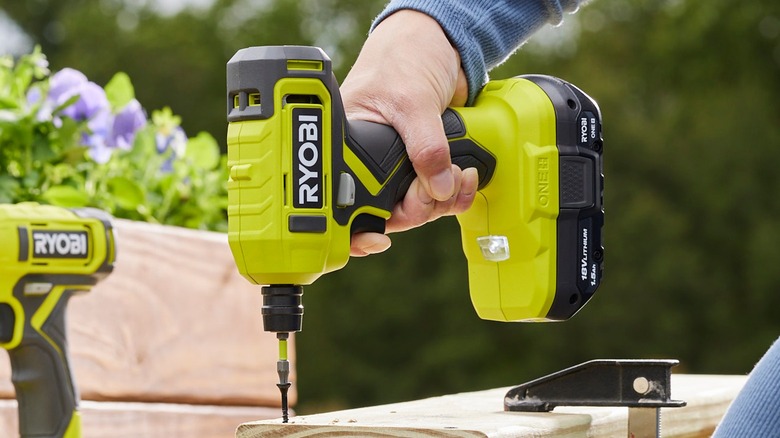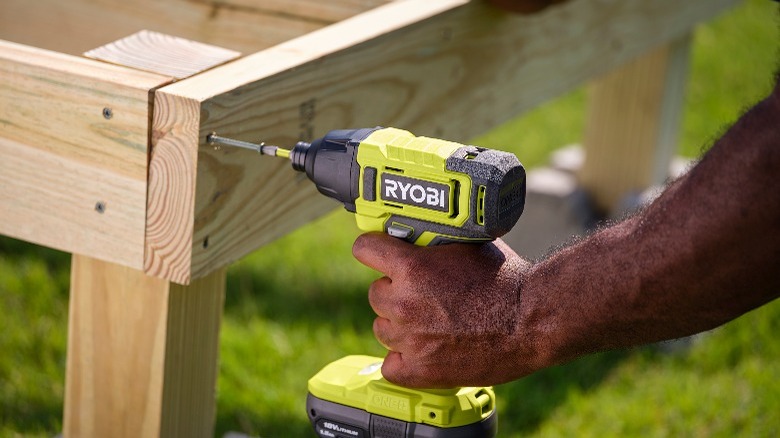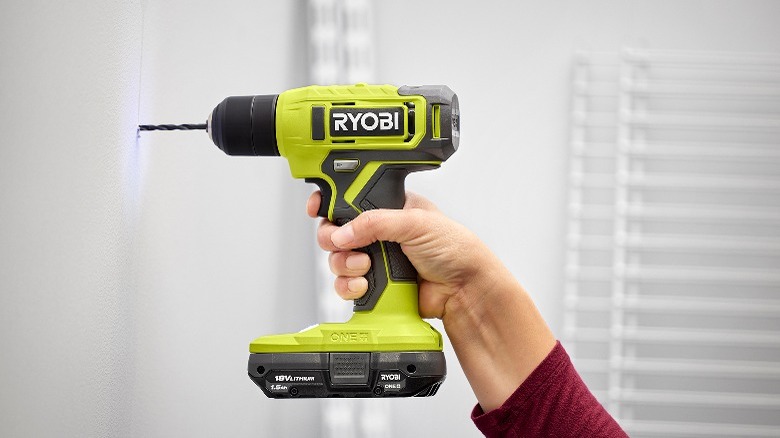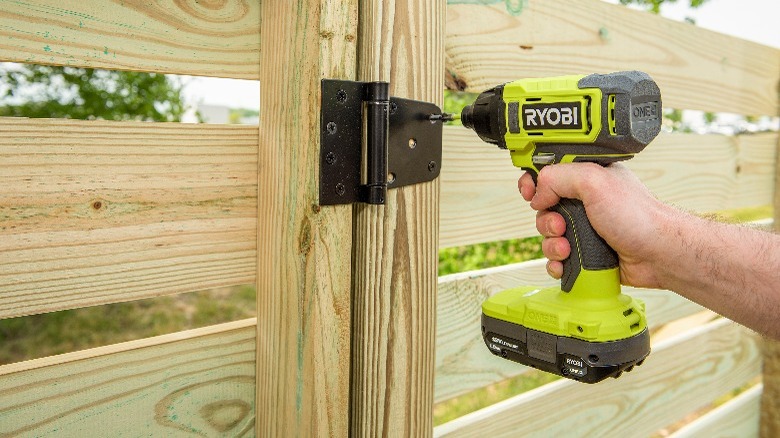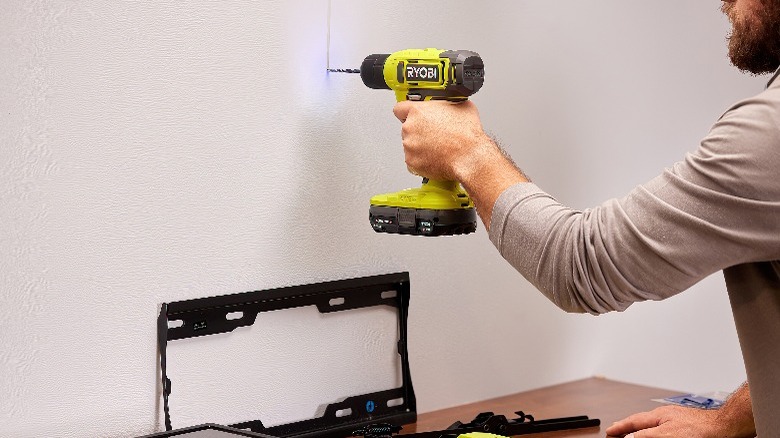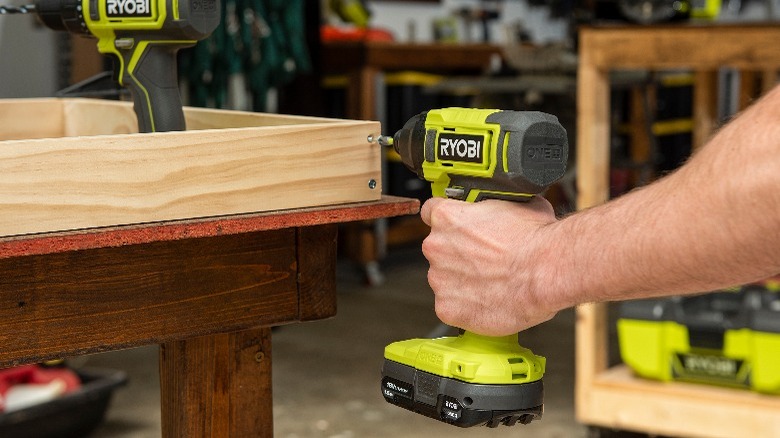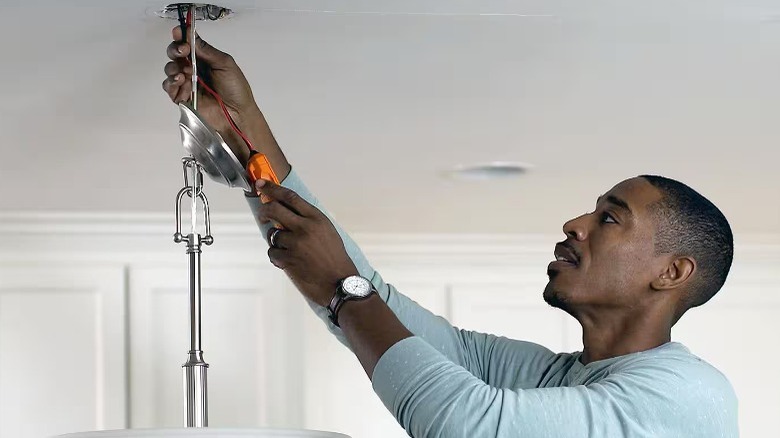Ryobi Tool Guide: When You Should (And Shouldn't) Use Your Impact Driver
We may receive a commission on purchases made from links.
The next time you find yourself perusing the selection of Ryobi-brand power tools at your local Home Depot, you might find yourself considering getting an impact driver. There are a lot of great brands that sell impact drivers. Ryobi sells them as stand-alone units, but the company also offers Kits that come with an 18V cordless drill, two batteries, a charger, and a carrying bag. This is a great starter set that should be able to handle all of the average DIYer's drilling and driving needs. But you might find yourself wondering what kind of projects the impact driver is best suited for.
Impact drivers are different from regular drills. They don't have the back-and-forth motion of a hammer drill, but they have a rotational impact mechanism and put out a considerable amount of torque. This allows them to drive fasteners with significantly more speed and force than a standard drill. The Ryobi model also has a quick-release hex-chuck, which makes it faster and easier to switch between bits. The flip side to this excess of power is that impact drivers offer considerably less control.
I've been building furniture and performing home renovations with both of these tools for a number of years, and I can tell you there are plenty of applications that are more suited to one than the other. Here are three times when you should use an impact driver and three times when you're better off with a regular drill.
Should: Building furniture
Ryobi's impact driver is great for building furniture. Whether you're building tables, dressers, chairs, desks, bookshelves, or a custom workbench, this tool will quickly become your best friend. Most of the furniture you'll build is probably going to be used either for sitting, eating, storage, or display. This means that it's going to need to bear weight, which in turn means that you're probably going to need to use a lot of long fasteners.
Although some woodworkers might consider it lazy, I'm personally a fan of using pocket holes for glue-ups and assembly. It's faster and easier than biscuits or dowels, and it makes the clamping process a lot more forgiving, but it means that you'll be drilling a lot of holes and driving a lot of pocket screws. You can technically do this with just a drill, but you'll constantly need to swap between drill and driving bits. The drill will also require more pressure to prevent slippage, and it will take more time on each screw.
Having an impact driver at the ready means you won't need to constantly adjust a chuck to switch out bits, and you will be able to tightly fasten screws and bolts with minimal effort. The driver's torque does most of the driving on its own, so once the screw gets a bite, all you need to do is hold on.
Shouldn't: Installing drywall
One of the best examples of a time when not to use an impact driver is when you are installing drywall. Drywall is primarily a gypsum core (with a few other trace ingredients) which is coated in paper. If you've ever cut or punched a hole in drywall, you know that gypsum is a crumbly material. It makes a good surface for walls and ceilings because it's cheap, rigid, well-insulated, relatively light, and easy to patch. But unfortunately, it lacks structural integrity. A lot of people don't know it, but the paper on the outside of the core is a big part of how the screws support the drywall's weight, so you want your screws to be tight enough to be flush with the ceiling but not so tight that they punch through the paper.
This is where the regular Ryobi drill is the better tool. You can lower the speed and adjust the maximum torque on the numbered clutch until the drill provides just enough power to bring the screwhead just below the paper's surface without sinking it all the way to the core. For me, this was around the 9th gear. This would be very difficult to do on the Ryobi impact driver. Even the tool's lowest 850 RPM setting would likely be much too powerful. Using this tool, it would be all too easy to accidentally sink screws all the way through the drywall and into the joist/stud.
Should: Building a deck, fence, or shed
An impact driver will definitely come in handy when building an outdoor structure such as a deck, fence, garden bed, or shed. I like to use self-drilling and countersinking construction screws for these kinds of projects. They use a T-25 star bit, which gives the drill a bit more grip than a standard Phillip's head. The yellow zinc coating also offers a level of rust resistance while the steel core is strong enough to bear weight and the self-tapping tips make it so you don't need to drill pilot holes so long as you have a drill with enough driving power.
This is where the Ryobi impact driver comes in. The speed and torque that this tool offers make driving fasteners like these a breeze for fence and deck planks. That makes a big difference when you're driving over a hundred screws into dense, pressure-treated structural posts over the course of a project. The fasteners will go in faster and require less pressure, saving you time and sparing your arm and shoulder muscles. The extra power also allows you to sink the screws into the wood a bit, which is particularly good for decks and underflooring since you don't want any metal sticking up where you might step on it.
Using this tool is also good for building structures such as sheds and Gazebos. You will have more torque and speed with which to drive and sink fasteners. Any long, structural bolts will also fly into place.
Shouldn't: Mounting a TV, shelves, or curtains
TVs, shelves, and curtains are usually mounted using wood or metal brackets and screws. The best practice is to mount any weight-bearing objects into a stud when possible so the wood behind the wall can bear the brunt of the burden. Other times, you may need to rely on drywall anchors. There are a couple of different kinds of these. The inferior, usually plastic, kind simply uses large ridges that expand to cast a wider grip on the inside of the loose gypsum. The better, usually metal, options have spring-loaded wings that open up behind the drywall and grip it from the back. These are also much better for wood paneling.
You don't really want to use the Ryobi impact driver in any of these situations, however. The high speed and overpowered torque will drive the screw into the drywall with crushing force. If you aren't extremely careful, this can easily result in you either stripping a large hole in the drywall that won't grant the screw any traction or denting the wall by crushing the bracket through it to reach the anchor on the other side. If this damages the Gypsum core, it will also lose its structural integrity and its ability to bear weight.
Tightening these fasteners by hand is often considered the best method for these kinds of applications, but if you really want to use a power tool, you should instead use the standard drill with the lower speed setting and the clutch set low enough that it won't damage the wall.
Should: Building and installing cabinetry
There are some things that you can mount to your wall with the Ryobi impact driver, though. Cabinets are a bit of an exception. Upper cabinets are typically mounted with the support of a ledger board and all of the mounting screws are driven directly into the studs. The majority of the tension is held between the threaded part of the fastener in the wooden studs and the counter-sunk heads in the ledger board and the cabinet itself. The pressure on the drywall panel in between has a wider displacement across the back of the boards on both sides, making it much less likely to be damaged.
Using an impact driver in these situations ensures that you will be able to get the cabinets mounted quickly, which will certainly be a bonus for the person helping you to hold them in place. It will also make certain that you have a strong, secure connection to the wall frame, which is vital when you consider the amount of weight that these storage compartments will be expected to bear. This is less pressing on the lower units, which have most of their weight supported by the floor, but using the Ryobi impact driver will still help you to get the job done quickly and make sure that your connection to the wall is tight.
Shouldn't: Installing light fixtures
Just like you don't want to use the Ryobi impact driver to mount curtains and shelf brackets to the walls, you also generally don't want to use it when installing light fixtures. Too much pressure when attaching the fixtures to the ceiling can cause them to pinch and crush the drywall around the cutouts. The metal frames that these fixtures are made from also aren't really designed to deal with that much torque, and the thinner ones can easily be bent out of shape. This is another instance where hand-screwing is probably your best bet, but a low-speed drill with a low clutch setting would be a reasonable option.
That said, the Ryobi impact driver might come in handy if you're replacing a light fixture with a fan and you don't already have a t-brace installed in your ceiling. If this is the case, then you will need to put one in before the fixture will be able to bear the extra weight. Some T-braces use teeth and clamping pressure to grip the joist structure, which doesn't require any drilling at all, while others need to be screwed into place. I recently installed one of these in my bedroom during a ceiling replacement and my impact driver made quick work of this part of the project.
